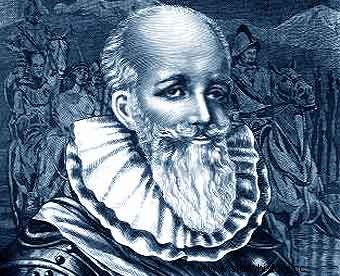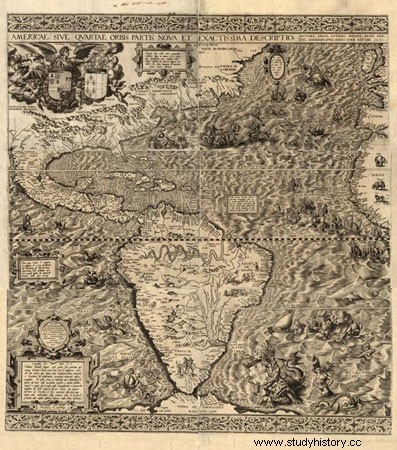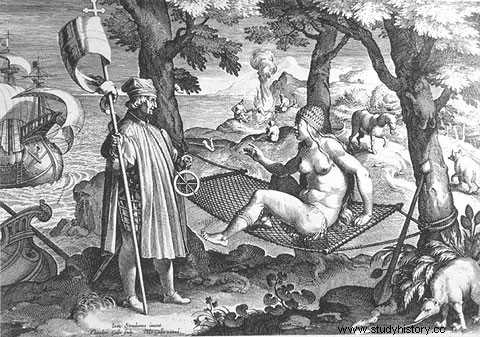 The discovery of the Indies was not narrated by historians but by the conquerors themselves who, either through their correspondence, or Through more elaborate writings, they made known to the world the adventures that led a handful of men to discover and colonize an entire continent.
The discovery of the Indies was not narrated by historians but by the conquerors themselves who, either through their correspondence, or Through more elaborate writings, they made known to the world the adventures that led a handful of men to discover and colonize an entire continent.
Bernal Díaz del Castillo is the best exponent of this genre. Born between 1495-1496 in Medina del Campo, we know little about his childhood and youth except that he was nicknamed "Galán". There is also no certainty about the hidalgo origin of his family. The first news we have about his life, told by himself, is that of his enrollment as a soldier at the young age of 18 in the expedition of Pedro Arias de Ávila to Darién in 1514. Once there and as a consequence of the unhealthy of the discovered lands and the internal dissensions, he decided to move to Cuba, at that time governed by Diego Velázquez. Hunger and ambition spurred him to join two expeditions that left the Caribbean island:the first in 1517 on the way to Yucatán under the command of Francisco Hernández de Córdoba and the second, the following year, under the tutelage of Juan de Grijalva ( his participation in the latter has raised certain doubts). Both companies are included in the first fifteen chapters of his True history of the conquest of New Spain .
In 1519 he enlisted in the army that Hernán Cortés was preparing to go to Mexico, which ultimately marked his entire life. Given his youth, he did not hold any command position, although he actively participated in the operations of Cortés's troops. After the conquest of the Aztec empire and the end of the Mexican wars, he joined the expeditions to subdue the Zapotecs and the minjes. He finally chose to settle in the town of Guazacualco and other territories were given to him, in gratitude for the services rendered. His sedentarization attempt was interrupted by the continuous rebellions in the region, which required his participation, and he had to go to put down the uprisings of the Zapotecs, from the provinces of Chiapas, Copilco and Jaltepeque.
As of the twenties of the 16th century, the first governors appointed by the Spanish monarch began to arrive in America, whose mission was to bring order to the new lands and claim the authority of the King versus that of the conquerors. Tensions arose due to the fact that the latter considered as theirs many of the lands that they themselves had attributed. Bernal Díaz del Castillo's position fluctuated depending on the ruler in power:sometimes he benefited from the concession of grants and land, while other times he was harmed, and was even imprisoned.
 Both the absences to put down the revolts and the vicissitudes before the representatives of the Crown caused him to be dispossessed of some of his lands, which led him to initiate a lawsuit to demand compensation and the restitution of his possessions. After some initial setbacks, he opted in 1540 to head back to the Iberian Peninsula in order to put his affairs in order. His claims were estimated by the Council of the Indies, which compensated him with parcels in Guatemala, of which he took possession. However, his joys did not last long and ten years later he had to return to Spain again to continue his litigation.
Both the absences to put down the revolts and the vicissitudes before the representatives of the Crown caused him to be dispossessed of some of his lands, which led him to initiate a lawsuit to demand compensation and the restitution of his possessions. After some initial setbacks, he opted in 1540 to head back to the Iberian Peninsula in order to put his affairs in order. His claims were estimated by the Council of the Indies, which compensated him with parcels in Guatemala, of which he took possession. However, his joys did not last long and ten years later he had to return to Spain again to continue his litigation.
In this second return he participated in the Juntas de Valladolid where he defended the need to perpetuate the distribution of land granted to the conquerors, which confronted Fray Bartolomé de las Houses. Once again his trip to the peninsula was fruitful and he returned to the Indies as corregidor and, later, "faithful executor" of the city of Santiago (today Asunción). The rest of his life passed without any setbacks other than those typical of his age and position, dedicated to writing and performing his functions in the town hall. He died in 1584.
Bernal Díaz del Castillo was not a scholar (he did not know Latin, essential at that time) nor an intellectual, much less a historian in the strict sense. He was a man of arms who at the end of his life changed the sword for the pen and recounted his experiences. His work is part of a large group of books that collect the experience of their authors in the Americas. Bernal Díaz del Castillo will surpass them all and his True Story of the Conquest of New Spain It is considered the greatest exponent of this genre that is difficult to classify. Composed of 214 chapters, the first fifteen deal with the author's first expeditions and most of the rest revolve around the life of Hernán Cortés.
One of the most debated questions about the work of Bernal Díaz del Castillo focuses on the reasons that pushed him to write. The scholars of him do not agree on which of them is the main one. For some it would be the need to vindicate the role played by the men of Hernán Cortés in the conquest of Mexico. The publication of the book by Francisco López de Gomara that extolled the figure of Cortés -and attributed all the glory to him for the conquest- seems to have led Díaz del Castillo to defend his own performance and that of his men. Hence, he presents Cortés's army as a collective unit in which decisions are made in common and the general only acts after having consulted with his men.
 Another of the reasons put forward would consist of the search for Mercedes:the account of his exploits and conquests would seek to attract favor and, in a way, to remind the monarch of the need to reward these men for the great work they did for the Crown. The third reason, the most personal, would be the desire to bequeath to posterity an imperishable memory of his experiences.
Another of the reasons put forward would consist of the search for Mercedes:the account of his exploits and conquests would seek to attract favor and, in a way, to remind the monarch of the need to reward these men for the great work they did for the Crown. The third reason, the most personal, would be the desire to bequeath to posterity an imperishable memory of his experiences.
Bernal Díaz del Castillo, as we have already said, was not a cultured man. He lacks a deep understanding of the classics, which are rarely cited, and his references to antiquity are vague and generic. However, he maintains certain patterns of classical historiography to which he was able to have second-hand access, including the use of indirect style, the inclusion of harangues and speeches, and the use of physical description and the character of the characters he portrays. .
The work revolves around the figure of Hernán Cortes whom Bernal Díaz del Castillo deeply admired, which does not prevent him from criticizing him, on occasions, for his vices such as excessive ambition and greed, and for his poor decisions in military and institutional matters. He also highlights the collective sense of the army and gives it a predominant role. His will to faithfully reflect what happened and extol his actors leads him to reject any supernatural intervention in the campaigns and to reject the miracles and intercession of the saints. Now, at all times it is present that victory is due to a design of the divine will, although its influence is only inspiring, not direct.
The most important of True history of the conquest of New Spain It is its testimonial value. No other work equals him in his ability to evoke the social and mental space of the conqueror of the early sixteenth century. The relevance of human value brings it closer to the Homeric epic, because instead of simply extolling a hero, it shows the complex relationship between the multitude of conquerors, individualizing their achievements and their defects. All this in the singular framework of novelty and strangeness that the clash of two civilizations supposed. Bernal Díaz del Castillo manages, through the immediacy of the narrated events, to vividly and intensely evoke the scenes of the conquest and makes the reader contemplate the events recounted, described with a plain and direct prose that catches and captivates when he leaves a record of the life of the conquerors, their ambition and courage, as well as the customs of the Indians.
